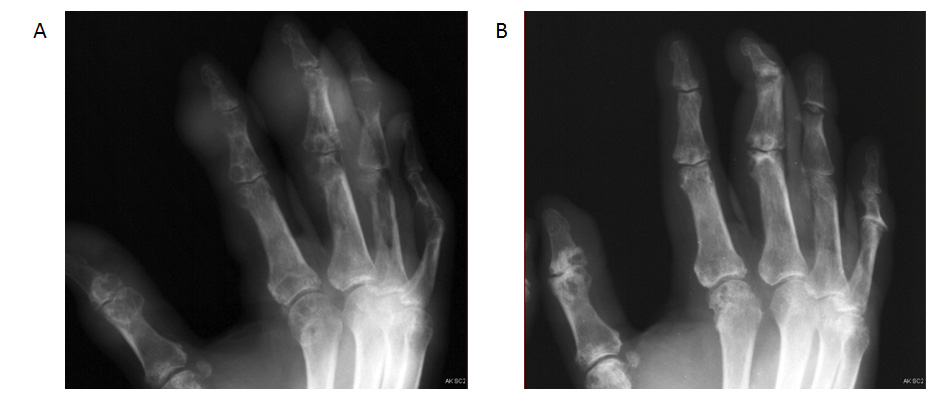Session Information
Session Type: Abstract Submissions (ACR)
Background/Purpose: In patients with gout, tophi are strongly associated with radiographic damage. Effective urate-lowering therapy (ULT) reduces tophus size. However, no studies to date have convincingly demonstrated that ULT can inhibit progression or promote healing of radiographic damage. Pegloticase therapy leads to dramatic reductions in serum urate (SU) concentrations and subcutaneous tophi in patients who respond to treatment. The aim of this exploratory analysis was to describe radiographic changes following treatment with pegloticase.
Methods: Serial plain radiographs of the hands and feet were obtained as standard of care from patients with severe chronic gout treated with pegloticase. Paired films at baseline and 12 months were available for nine patients. Five of these patients had films at baseline, 12 and 24 months. Radiographs were analysed sequentially in chronological order by two observers; a musculoskeletal radiologist and a rheumatologist with experience in radiographic scoring. Radiographs were scored for erosion and joint space narrowing according to the modified Sharp-van der Heijde method, validated for gout. Scorers were blinded to each other’s scores and to the clinical characteristics of the patients (including the clinical response to pegloticase). Inter-observer ICCs were 0.89 (0.76-0.95) for total scores and 0.83 (0.53-0.94) for change scores. A detailed qualitative site-by-site analysis was also undertaken to define additional changes observed from baseline.
Results: All patients had sustained SU <1 mg/dL during pegloticase treatment. For the entire group, median (range) total radiographic scores reduced from 73 (1.5-138) at baseline to 60.5 (1.5-110) at 12 months, p=0.01. Median (range) erosion scores reduced from 48.5 (1.5-98.5) at baseline to 42.0 (1-71.5) after one year, p=0.003. In contrast, narrowing scores did not change over the one year period; baseline narrowing scores were 24.5 (0-43) and at one year 22.5 (0.5-41.5), p=0.26. Further reductions were observed in total scores and erosion scores in the five patients with films available at 24 months following treatment, but not in narrowing scores (one way ANOVA p=0.009 for total score, 0.02 for erosion and 0.95 for narrowing). Qualitative site-by-site analysis identified regression of soft tissue masses, increased sclerosis, and filling in of erosions in the follow-up films (Figure).
Conclusion: This exploratory analysis suggests that intensive urate-lowering therapy can lead to improvement in structural damage, particularly bone erosion, in patients with severe chronic gout.
Figure. Paired radiographs of the fingers of the right hand in a patient with tophaceous gout A. at baseline, B. after one year of pegloticase therapy.
Disclosure:
N. Dalbeth,
Ardea Biociences,
5,
TAP Pharmaceuticals Inc.,
5,
Metabolex,
5;
A. Doyle,
None;
F. M. McQueen,
None;
J. S. Sundy,
Ardea Biosciences,
2,
Ardea Biosciences,
5,
Regeneron,
2,
Regeneron,
5,
Metabolex,
2,
Metabolex,
5,
Pharmos,
2,
Pharmos,
5,
Savient,
5,
Savient,
2,
Celgene,
2,
General Electric,
1,
Academic Partners for Medical Education, LLC,
4,
Medanta Duke Research Institute,
6,
Bristol-Myers Squibb,
2,
Bristol-Myers Squibb,
5;
H. S. B. Baraf,
SAVIENT, TAKEDA, Ardea,,
5,
SAVIENT, TAKEDA, Ardea, Metabolex, Novartis, Regeneron,
2,
SAVIENT, TAKEDA,
8.
« Back to 2012 ACR/ARHP Annual Meeting
ACR Meeting Abstracts - https://acrabstracts.org/abstract/exploratory-analysis-of-radiographic-change-in-patients-treated-with-intensive-urate-lowering-therapy/

